

Forbes Welcome. Nanotechnology and Space. This paper was presented at the Fourth Foresight Conference on Molecular Nanotechnology by Thomas Lawrence McKendreeMolecular Manufacturing Shortcut Group 8381 Castilian Drive Huntington Beach, CA 92646 USA Nanotechnology Implications on Space Systems PACS Classification Numbers Table of Contents List of Tables List of Figures Molecular nanotechnology offers the prospect for significant increases in various technical performance parameters, such as material strength and density.
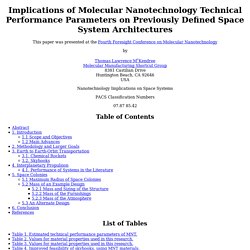
Moving Mesh Cosmology. This website presents online material related to the first cosmological simulations of galaxy formation with the new moving mesh code AREPO.

NEWS: 09/13/13: Galaxy mergers on a moving mesh: a comparison with smoothed-particle hydrodynamics 05/13/13: A physical model for cosmological simulations of galaxy formation Moving mesh cosmology: numerical techniques and global statistics Mark Vogelsberger, Debora Sijacki, Dusan Keres, Volker Springel, Lars Hernquist We present the first hydrodynamical simulations of galaxy formation using the new moving mesh code AREPO and compare the results with equivalent GADGET simulations based on the traditional smoothed particle hydrodynamics (SPH) technique.
Both codes use an identical Tree-PM gravity solver and include the same sub-resolution physics for the treatment of star formation, but employ a completely different method to solve the inviscid Euler equations. Public Release of a Queryable Database of Galaxies in the Milennium Simulation. When published in 2005, the Millennium Run was the largest ever simulation of the formation of structure within the ΛCDM cosmology.
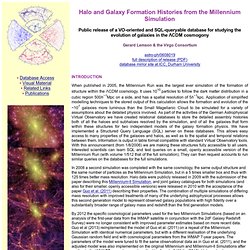
It uses 1010 particles to follow the dark matter distribution in a cubic region 500h−1Mpc on a side, and has a spatial resolution of 5h−1kpc. Cooling flows, black holes and the luminosities and colours of galaxies. Mad Scientist Worm-hole Generator. This is always the hardest part because a worm-hole generator a work of art (not to mention maniacal genius); therefore, you should choose your parts carefully.
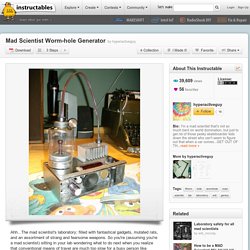
You need something to house your generator. I used some sort of strainer, but ultimately, it's up to you. Then you need some parts, use whatever you want, just make sure you can explain how it works. If you can't then you probably won't be able to teleport anywhere. Look at the picture to see what I used. Same story as the Intro, here's the notes...Starting fom TOP LEFT and continuing as if you were reading. Wormholes in fiction. STEPHEN HAWKING: How to build a time machine. By STEPHEN HAWKING Created: 18:47 GMT, 27 April 2010 All you need is a wormhole, the Large Hadron Collider or a rocket that goes really, really fast 'Through the wormhole, the scientist can see himself as he was one minute ago.
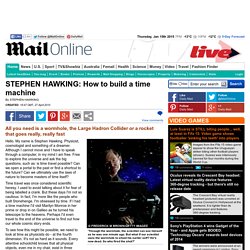
But what if our scientist uses the wormhole to shoot his earlier self? He's now dead. Hello. Time travel was once considered scientific heresy. To see how this might be possible, we need to look at time as physicists do - at the fourth dimension. But there is another kind of length, a length in time. To see what that means, let's imagine we're doing a bit of normal, everyday car travel.
Let's indulge in a little science fiction for a moment. Physicists have been thinking about tunnels in time too, but we come at it from a different angle. Enlarge Nothing is flat or solid. Unfortunately, these real-life time tunnels are just a billion-trillion-trillionths of a centimetre across. The fastest manned vehicle in history was Apollo 10. Paradoxes are fun to think about. Wormhole. A wormhole, officially known as an Einstein–Rosen bridge, is a hypothetical topological feature of spacetime that would fundamentally be a "shortcut" through spacetime.

A wormhole is much like a tunnel with two ends each in separate points in spacetime. Big Bang Discovery Opens Doors to the "Multiverse" Bored with your old dimensions—up and down, right and left, and back and forth?
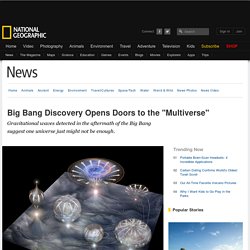
So tiresome. Take heart, folks. The latest news from Big Bang cosmologists offers us some relief from our humdrum four-dimensional universe. Gravitational waves rippling through the aftermath of the cosmic fireball, physicists suggest, point to us inhabiting a multiverse, a universe filled with many universes. (See: "Big Bang's 'Smoking Gun' Confirms Early Universe's Exponential Growth. ") That's because those gravitational wave results point to a particularly prolific and potent kind of "inflation" of the early universe, an exponential expansion of the dimensions of space to many times the size of our own cosmos in the first fraction of a second of the Big Bang, some 13.82 billion years ago. "In most models, if you have inflation, then you have a multiverse," said Stanford physicist Andrei Linde. Lunchtime Comic Mismatches "I'm a fan of the multiverse, but I wouldn't claim it is true," says Guth.
Ebook : gravitational waves. The universe is home to some amazing things!
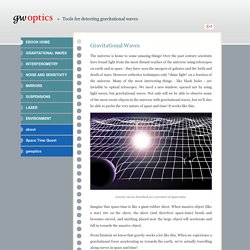
Over the past century scientists have found light from the most distant reaches of the universe using telescopes on earth and in space - they have seen the mergers of galaxies and the birth and death of stars. However orthodox techniques only *shine light* on a fraction of the universe. Many of the most interesting things - like black holes - are invisible to optical telescopes. We need a new window: opened not by using light waves, but gravitational waves.